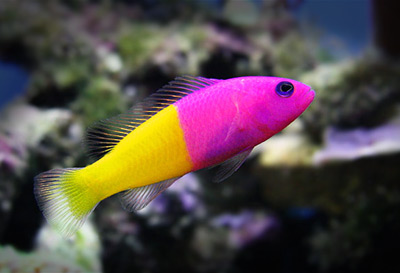Often described as a purple fish that looks like it’s been dipped in yellow paint (or is it a yellow fish that’s been dipped in purple paint?), the royal, or bicolor, dottyback (Pictichromis paccagnellae) is a visually stunning marine species with the added benefits of being very hardy, easy to feed, and suitable for relatively small aquariums.
On the downside, this Western Pacific species’ highly territorial and aggressive nature belies its diminutive size and can prove problematic depending on the tankmates chosen and other circumstances. Still, P. paccagnellae can be a worthy aquarium candidate as long as the hobbyist is careful to make accommodations for its bellicose nature.
Physical traits
The royal dottyback’s body is slender and elongated. Color-wise, as alluded above, it’s purple from snout to mid-body and bright yellow from mid-body through the tail. The irises of the eyes are purple, and the pupils are, typical of dottybacks, pear-shaped. The maximum recorded size for this species is close to three inches.
Feeding
The royal dottyback is a carnivore, and captive specimens will readily accept a wide variety of small meaty fare, such as mysids, plankton, brine shrimp, chopped mollusk or crustacean flesh, and frozen carnivore formulations. Dry foods, such as New Life Spectrum pellets, will also be accepted. Once-daily feedings will suffice for this species.
Housing
Owing to its diminutive size and tendency to stay in close proximity to its favored hiding place, P. paccagnellae doesn’t require a great deal of open swimming space. Thus, it can be a good choice for smaller systems—in the range of 20 to 30 gallons. Keep in mind, however, that depending on the tankmates kept (if any), a larger system may be necessary to avoid serious territorial issues. The tank should be well covered to prevent jumping, and the rockwork should be arranged to provide lots of hiding places.
Compatibility
The crux of the compatibility issue with P. paccagnellae is not only that the species is territorially aggressive, but also that each individual claims a quite sizeable territory—well beyond the size of most home aquariums—for itself. Thus, keeping conspecifics, similar-looking heterospecifics, or typically shy, retiring species in the same tank is generally ill-advised.
In choosing tankmates, you have to walk a fine line. They need to be big and assertive enough to shrug off the dottyback (this species is renowned for squaring off with fish much larger than itself) yet disinclined to make a meal of it. Also, be sure to introduce the dottyback after any of the more peaceful specimens—which usually means last.
In my opinion, one of the best ways to keep and enjoy a royal dottyback is as the lone fish occupant of a nano system. That way you don’t have to worry about compatibility with other fish at all.
As far as reef candidacy is concerned, P. paccagnellae is a pretty good choice, though it will eat small crustaceans, so be sure to take that into account if your tank contains (or will contain) small ornamental shrimps.




